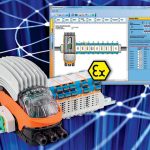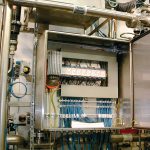Cytec, a manufacturer of carbon-fibre reinforced plastics, has strict requirements for the components used in its equipment. At its Östringen works, the explosion-proof Antares remote I/O processes signals for the control and feedback system of the air extraction plant in the resin manufacturing department, the most important part of the production process for high-performance fibre-reinforced composite materials. Once the exhaust air plant was up and running, the customer heard nothing more from the system, meaning that it had met all expectations.
Author Ulrich Stumpf Sales Germany, Bartec
Cytec is one of the world’s ten largest manufacturers of carbon fibre-reinforced plastics. In 2012 this American company achieved sales of 1.7 billion euros. According to an up-to-date market report published by the German Federation of Reinforced Plastics and the Carbon Composites Association, this industrial sector will experience major growth in the coming years. Based on an assumed global production of 108,000 t of fibre-reinforced materials in 2015, it is estimated that this figure will increase to 208,000 t by 2020. The main drivers of this growth are wind turbines, closely followed by the aerospace and defence sector, sports & leisure and automotive; it is the latter area that has the greatest potential. The aerospace and defence segment, in which Cytec operates, is dominated by the aircraft industry. Airbus and Boeing, the two leading companies in this market, are anticipating a major upswing in order intake between now and 2030. There is talk of approximately 30,000 new aircraft each during this period.
Air extraction plant redesigned
Cytec’s Östringen works specialises in combining carbon fibres with epoxy resin to make highest-grade carbon fibre-reinforced plastics in what are called semi-finished forms. Resin manufacture is therefore the lynch-pin of the entire factory. Everything stops without it. At the beginning of the year the company refurbished the mixer’s air extraction plant – starting with the pipework, moving on to the control system and finally the valves.
This area is classed as Ex Zone 1 because an extremely wide range of organic solvents are used there. The team were allowed only two and a half weeks to install the entire plant. The objective is to pre-clean the exhaust gases containing dust and solvents which are generated during the process, then convey them to the combustion plant in a controlled manner. They have to be brought to a level at which they no longer constitute a highly explosive mixture and can be burnt in line with German clean air regulations.
The air extraction plant was completely redesigned and fitted with a control system that aligned it to the state of the art. This also meant new pipe cross-sections, pipework systems and flow rates. In the past the solvents were simply burnt. Today, 200 kg of solvent can be reintroduced into the production cycle after every three shifts. A further shortcoming of the old plant was that it often had to be completely dismantled and cleaned. With the new plant, this is now a thing of the past. When the payback period was calculated, solvent recovery was assumed to be 100 l per three shifts. The plant is therefore working even more efficiently than expected.
Flexible extension in the hazardous area
The complete air extraction plant in the resin manufacturing department, including all valves and the entire sensor system, is operated and controlled by Bartec’s Antares Ex remote I/O system, which can be directly installed in the hazardous area (Zones 1 and 2 or Zones 21 and 22) and is certified to the latest Atex and IEC Ex directives. Thanks to its flexible official approval, Antares can be configured and extended as required without having to arrange for additional certification. Until now, remote I/O systems had to be clearly planned in advance and housed in Ex-e-certified casings with a fixed approval. By contrast, the remote I/O system from the explosion protection specialists in Bad Mergentheim, Germany, gets by with a simple and affordable, mechanically protected, standard industrial casing. The system installed at Cytec controls 80 valves, 160 feedback signals, approximately 15 temperature sensors and four clamp-on ultrasonic flow meters. Added to these are ten differential pressure monitors, eight level sensors, flux measuring devices, flame barriers, control valves, etc.
Up-to-date communication
Due to its huge power reserves, the Antares system facilitates efficient and compact I/O configurations. It can supply up to 32 multi-channel modules via a single rail control unit (RCU), resulting in a very large number of input/output channels. In view of their compact design, the I/O modules take up little space and can be installed on standard mounting rails. The internal bus connection is made by simply clipping the modules together. All I/O modules are manufactured to comply with Ex i protection requirements. The connections to the module for the incoming signals are also of the plug-in type.
The central unit is the RCU featuring host communication, an Ethernet switch, power management and I/O data management. The system supports many open communication standards – from fully redundant Profibus-DP to Ethernet standards such as Profinet, Modbus TCP and Ethernet/IP. The Cytec team developed a star-shaped Ethernet topology for the entire system and its 13 control units; the Bartec system uses this layout to report to a fail-safe master control unit. There are no large cabinets in the hazardous area. All signals are collected using Profibus or Ethernet. Truly redundant communication with Profibus-DP ensures uninterrupted operation with the host system. This guarantees a high level of availability which is further increased by the hot-swap capability of the RCU and the I/O mod-ules. Standard bus systems can also be connected. As a result of this, additional explosion-proof components, for example buffer amplifiers, are superfluous.
Easily installed and configured
Thanks to the intuitive Antares Designer software, the remote I/O can be installed and configured with just a few mouse clicks. A WYSIWYG view shows the actual structure of the system to scale as it is created. At the same time, the programme checks compliance with specific threshold values such as distances, power management and the maximum data length on the Profibus. The software is also equipped with a constructor which calculates the necessary inputs and outputs, including the reserves required for the optimal (i.e. most economical) system. The system has operated without any problems ever since it was first started up.
cpp-net.com/0314426
Share:








